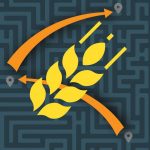The CIMMYT germplasm bank is home to over 140,000 wheat and 28,000 maize samples that represent invaluable genetic diversity. To increase utilization of these materials for crop improvement, the Seeds of Discovery (SeeD) initiative uses cutting-edge genetic analysis technology to explore the diversity of the CIMMYT maize and wheat genebanks to identify useful, novel genetic diversity to introduce to breeding programs.

Cultivation of maize seedlings to sample leaves from 30 individuals per accession for DNA extraction (three accessions per tray). Photo: CIMMYT.
SeeD characterizes the genetic makeup of maize and wheat collections and bridging germplasm, through the high-end DNA sequencing technology of the Genetic Analysis Service for Agriculture (SAGA). By identifying molecular markers for maize and wheat varieties with specific gene forms, or alleles, associated to resistance to stresses such as drought, heat, pests and diseases, SeeD will help breeders develop the improved varieties farmers need to feed a growing population in a changing climate.
By mid-2016, approximately 100,000 wheat and 44,500 maize samples have been genotyped by the project, generating comprehensive datasets describing the genetic diversity of two of mankind’s major food crops. These datasets are being made publically available on the SeeD website, in Germinate and Dataverse, for use by researchers, students and anyone interested in working with genotypic data worldwide.
What is SAGA?
SAGA is a research and service laboratory that uses a genotyping platform based on the DArTseq method, developed to create genomic profiles of maize and wheat varieties. This technology is based on re-sequencing a small, well-defined fraction of the genome (a ‘genome representation’), corresponding to 0.1–1% of the genome. Genome representations are prepared using ‘complexity reduction’ methods that reproducibly select a well-defined subset of DNA loci (‘tags’) from the genome. Restriction enzymes (RE) based complexity-reduction methods separate low copy sequences (most informative for marker discovery and typing) from the repetitive fraction of the genome, making an advantageous selection of genome fraction corresponding predominantly to active genes.
The sequencer at SAGA can read up to 100,000 samples annually and generates large quantities of data at a comparatively low price. Located at CIMMYT headquarters outside of Mexico City, it is the only genotyping technology of its kind located in Mexico.
SAGA provides genotyping services to a number of national and international collaborators, including MasAgro, CIMMYT, ICARDA, INIFAP, private companies and universities. If you are interested in learning more about how SAGA could be utilized to support and enhance your research or your breeding program, please contact Dr. Carolina Sansaloni (c.sansaloni@cgiar.org) or Dr. Cesar Petroli (c.petroli@cgiar.org).

Large-scale wheat characterization trial at CIMMYT’s headquarters where one representative plant per accession was sampled for DNA extraction. Photo: CIMMYT.
SeeD also offers a number of publicly available resources to facilitate the visualization and analysis of data, including tools to help researchers better utilize and visualize the genotypic data produced by SAGA. In addition, the project offers training in this technology to Mexican researchers and students through courses and visits are offered each year.
SAGA is a partnership between CIMMYT and Mexico’s Ministry of agriculture and rural development (SADER) through the MasAgro (Sustainable Modernization of the Traditional Agriculture) project, with the support of a private company from Australia, Diversity Arrays Technology (DArT).
For more information please contact us at: seed@masagro.org















